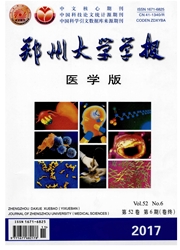

 中文摘要:
中文摘要:
目的探讨全面性癫痫伴热性惊厥附加症(GEFS^+)的临床表型及遗传规律。方法首先对15个GEFS^+家系的先证者进行详细的问诊及体格检查,建立完善的家系图谱,部分患者行EEG、头颅CT或MRI检查,按照国际分类法对癫痫发作和癫痫综合征进行分类,然后进行临床分析。结果15个家系共196名成员,75例患有癫痫,其中64例表型与GEFS^+一致(1例去世),男性38例,女性26例,性别差异无显著性(P〉0.05)。发作起始年龄均在儿童期。表现为热性惊厥(FS)者44例,FS伴肌阵挛1例,热性惊厥附加症(FS^+)者13例,FS^+伴失神发作2例,FS^+伴肌阵挛1例,FS^+伴局灶性发作3例。结论GEFS^+具有表型异质性和遗传异质性,常见表型为FS和FS^+,少见的表型为FS^+伴失神发作、FS^+伴肌阵挛发作、巧’伴局灶性发作等。GEFS’家系中父母一方患病,男女发病机率均等,符合常染色体显性遗传。
 英文摘要:
英文摘要:
Objective To investigate the clinical phenotypes and hereditary patterns of the generalized epilepsy with febrile seizures plus ( GEFS ^+ ). Methods Detailed family trees were constructed by inquire and physical examinations for the probands of the 15 pedigrees of GEFS^+. Some patients received electroencephalography, cranial CT or MRI examination. The seizures and epilepsy syndromes were classified according to the 2001 Seizure International Classification. The clinical data of GEFS^+ were reviewed. Results The 15 families consisted of 196 individuals. Seventyfive individuals were confirmed with epilepsy. The phenotypes of 64 out of the 75 patients with epilepsy conformed to GEFS ^+. The 64 patients included 38 males and 26 females ( 1 deceased) and there was no gender difference in the morbility of GEFS^+. The age at onset was all in childhood. GEFS^+ had a diversity of phenotypes. Febrile seizures(FS) were confirmed in 44 patients, FS and myoclonic seizure in 1, febrile seizures plus (FS^+ )in 13, FS^+ and absence seizure in 2, FS^+ and myoclonic seizure in 1, and FS^+ and focal seizure in 3. Conclusions The heterogeneity of phenotypes and genetics may be the hallmarks of GEFS^+. FS and FS^+ are common phenotypes while FS^+ and absence seizure, FS^+ and myoclonic seizure, and FS+ and focal seizure are rare. If one of the parents is affected in a GEFS^+ family, the susceptibility of their children to GEFS^+ is the same no matter what gender of their children is. It is speculated that the hereditary pattern of GEFS^+ conforms to autosomal dominant inheritance.
 同期刊论文项目
同期刊论文项目
 同项目期刊论文
同项目期刊论文
 期刊信息
期刊信息
